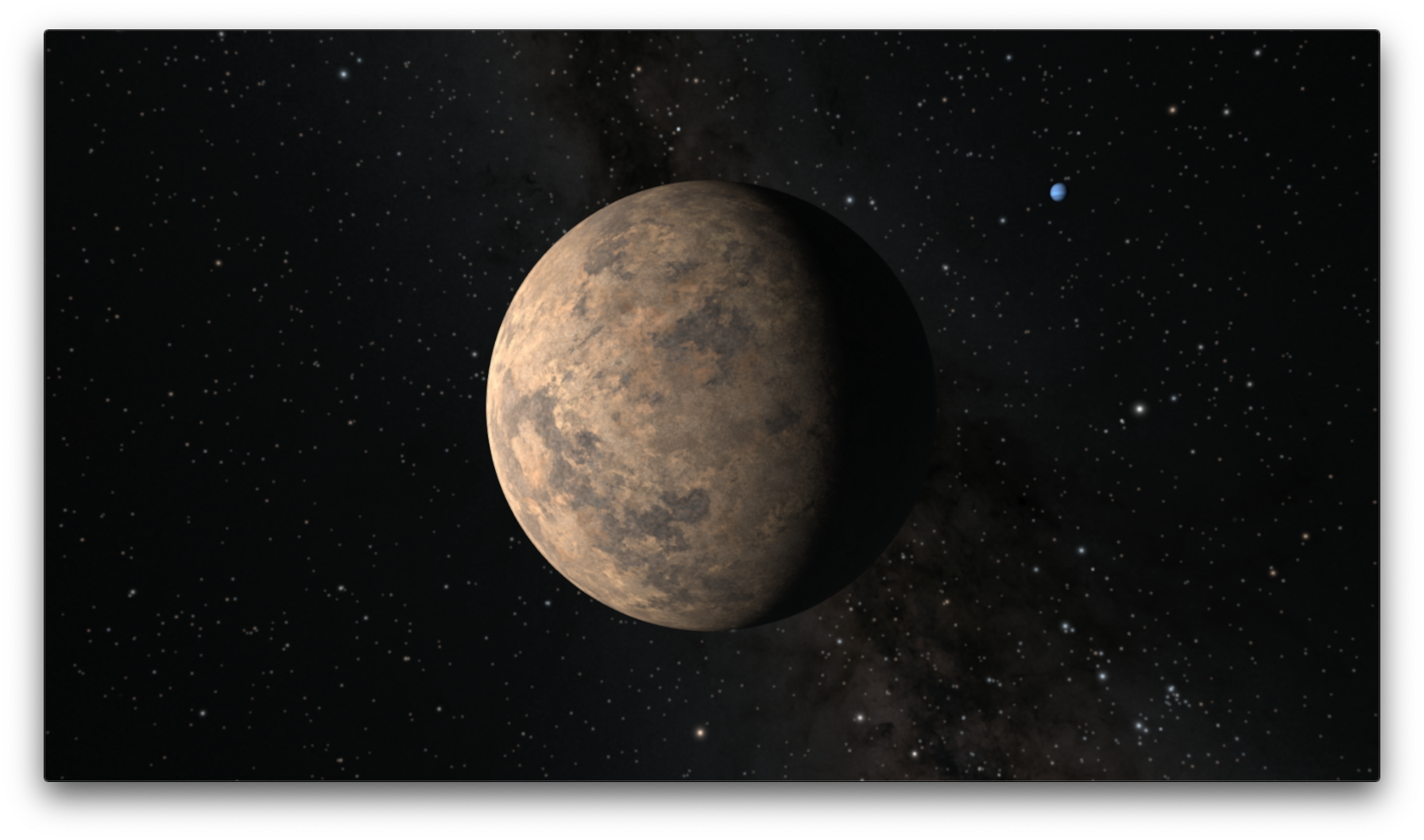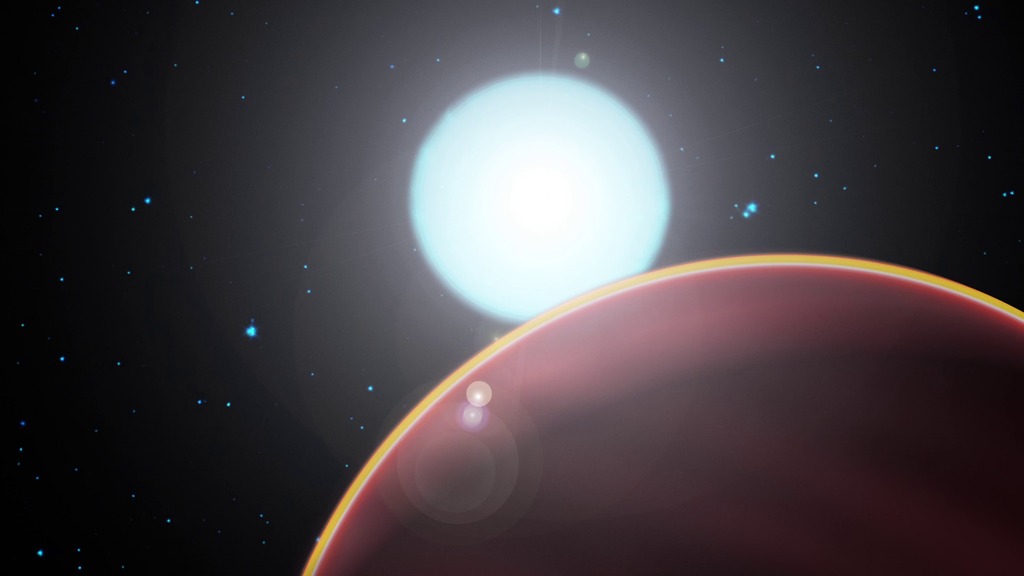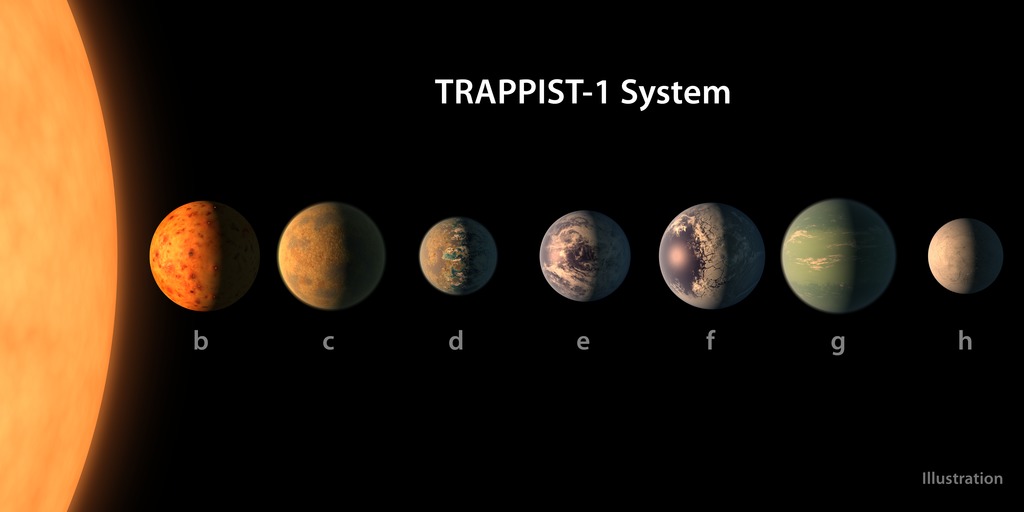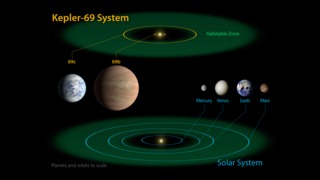Exoplanets
Overview
An exoplanet is a planet orbiting a star other than the Sun. Of particular interest are planets that may orbit in their star’s habitable zone, the distance from a star where temperatures allow liquid water to persist on a planet’s surface, given a suitable atmosphere. Since water is necessary for life as we know it, its presence is required for worlds to be considered capable of supporting life. Exoplanets can also teach us more about planets in the universe, such as the diversity of planets in the galaxy, how they interact with their host stars and with each other, and how common solar systems like ours really are.
Using a wide variety of methods, astronomers have discovered more than 3,700 exoplanets to date, largely thanks to NASA's Kepler/K2 mission.
Other NASA missions also play a key role in detecting exoplanets. The Transiting Exoplanet Survey Satellite, which launched in April 2018, will monitor 200,000 of the brightest dwarf stars for transiting exoplanets. Future missions like the James Webb Space Telescope will be able to study these discovered planets in greater detail, helping determine their composition.
Researchers in NASA Goddard Space Flight Center's Sellers Exoplanet Environments Collaboration are leveraging work across disciplines to better understand exoplanets. Areas like planet-star interactions, planetary formation, and even study of the Earth itself enable researchers to develop tools to learn more about how exoplanets evolve, and what ingredients are necessary to support life.
Artist's Illustrations
Artist's illustrations of exoplanets, NASA exoplanet missions, and detection methods. Includes animations and stills.
- Produced Video
- Produced Video
- Produced Video
- Produced Video
- Animation
- Produced Video
- Produced Video
- Animation
- Produced Video
- Produced Video
- Produced Video
- Animation
- Animation
- Animation
- Produced Video
- Produced Video
- Animation
- Animation
- Produced Video
- Produced Video
- Produced Video
- Produced Video
Research Model Visualizations
Visualizations of exoplanets and models. Based on real data from modeling tools and/or missions. Learn more about the latest exoplanet modeling tools.
Exoplanet Disks In Formation
Go to this pageThis visualization provides a full 360-degree rotating tour of the disk, face-on to edge-on and back. || NesvoldDiskMergeOrtho.brightness_orbit.0000_print.jpg (1024x576) [108.8 KB] || NesvoldDiskMergeOrtho.brightness_orbit.0000_searchweb.png (320x180) [41.0 KB] || NesvoldDiskMergeOrtho.brightness_orbit.0000_thm.png (80x40) [3.1 KB] || OrbitDisk (1920x1080) [64.0 KB] || NesvoldDiskMergeOrtho_1080p30.mp4 (1920x1080) [24.0 MB] || NesvoldDiskMergeOrtho_1080p30.webm (1920x1080) [2.2 MB] ||
Exploring Exoplanet Parameters
Go to this pageThe NASA Exoplanet Archive is an online astronomical exoplanet and stellar catalog and data service that collates and cross-correlates astronomical data and information on exoplanets and their host stars and provides tools to work with these data. || rachel_akeson_01_exoplanet_archive_print.jpg (1024x574) [170.3 KB] || rachel_akeson_01_exoplanet_archive.png (4104x2304) [5.0 MB] || rachel_akeson_01_exoplanet_archive_web.png (320x180) [70.6 KB] || rachel_akeson_01_exoplanet_archive_searchweb.png (320x180) [70.5 KB] || rachel_akeson_01_exoplanet_archive_thm.png (80x40) [5.9 KB] || rachel_akeson_01_exoplanet_archive.hwshow [117 bytes] ||
Kepler Stares at Neptune
Go to this pageIn late 2014 and early 2015, NASA's Kepler telescope observed the eighth planet in our solar system, Neptune. Kepler detected Neptune's daily rotation, the movement of clouds, and even minute changes in the sun's brightness, paving the way for future studies of weather and climate beyond our solar system. Complete transcript available.Watch this video on the NASA Goddard YouTube channel.Music Provided by Killer Tracks:"Lost Contact" – Adam Salkeld & Neil Pollard"Processing Thoughts" – Theo Golding || Neptune-Triton-Zoom-Thumbnail.jpg (1920x1080) [1.2 MB] || 4559_Kepler_Neptune_Twitter_720.mp4 (1280x720) [30.6 MB] || WEBM-4559_Kepler_Neptune_APR.webm (960x540) [58.6 MB] || Neptune-Triton-Zoom-Thumbnail_Big.tiff (1920x1080) [11.9 MB] || 4559_Kepler_Neptune_Facebook_720.mp4 (1280x720) [173.0 MB] || 4559_Kepler_Neptune_Captions_Output.en_US.srt [2.8 KB] || 4559_Kepler_Neptune_Captions_Output.en_US.vtt [2.9 KB] || 4559_Kepler_Neptune_APR.mov (1920x1080) [1.9 GB] || 4559_Kepler_Neptune_APR_4444.mov (1920x1080) [4.1 GB] || 4559_Kepler_Neptune_APR.mov.hwshow [205 bytes] ||
The Planet Around Beta Pictoris Makes Waves
Go to this pageWatch: Erika Nesvold and Marc Kuchner discuss how their new supercomputer simulation helps astronomers understand Beta Pictoris.Music:"Deep Layer" by Lars Leonhard, courtesy of the artist.Watch this video on the NASA Goddard YouTube channel. Video credit: NASA's Goddard Space Flight CenterFor complete transcript, click here. || Beta_Pic_Disk_Sim_Still.jpg (1920x1080) [330.2 KB] || Beta_Pic_Disk_Sim_Still_print.jpg (1024x576) [96.2 KB] || Beta_Pic_Disk_Sim_Still_thm.png (80x40) [5.3 KB] || 11896_Beta_Pic_Disk_ProRes_1920x1080_2997.mov (1920x1080) [3.5 GB] || 11896_Beta_Pic_Disk_H264_Best_1920x1080_2997.mov (1920x1080) [2.1 GB] || 11896_Beta_Pic_Disk_H264_Good_1920x1080_2997.mov (1920x1080) [321.8 MB] || 11896_Beta_Pic_Disk_MPEG4_1920X1080_2997.mp4 (1920x1080) [100.6 MB] || G2015-052_Beta_Pic_Disk_Final_appletv.m4v (960x540) [97.4 MB] || G2015-052_Beta_Pic_Disk_Final_1280x720.wmv (1280x720) [109.6 MB] || 11896_Beta_Pic_Disk_H264_Good_1920x1080_2997.webm (1920x1080) [30.4 MB] || G2015-052_Beta_Pic_Disk_Final_appletv_subtitles.m4v (960x540) [97.3 MB] || G2015-052_Beta_Pic_Disk_Final_ipod_lg.m4v (640x360) [41.5 MB] || 11896_Beta_Pictoris_Disk_SRT_Transcript.en_US.srt [5.5 KB] || 11896_Beta_Pictoris_Disk_SRT_Transcript.en_US.vtt [5.5 KB] || G2015-052_Beta_Pic_Disk_Final_ipod_sm.mp4 (320x240) [20.7 MB] ||
Solar Wind Strips the Martian Atmosphere
Go to this pageScientists have long suspected the solar wind of stripping the Martian upper atmosphere into space, turning Mars from a blue world to a red one. Now, NASA's MAVEN orbiter is observing this process in action, providing significant data on solar wind erosion at Mars.Watch this video on the NASA Goddard YouTube channel.Complete transcript available.This video is also available on our YouTube channel. || MarsAtmoLossExplainPreview.jpg (1920x1080) [993.6 KB] || APPLE_TV_4370_MAVEN_Mars_Atmo_Loss_appletv_subtitles.m4v (1280x720) [53.7 MB] || WEBM_4370_MAVEN_Mars_Atmo_Loss_APR.webm (960x540) [44.7 MB] || 4370_MAVEN_Mars_Atmo_Loss_appletv.m4v (1280x720) [53.7 MB] || NASA_TV_4370_MAVEN_Mars_Atmo_Loss.mpeg (1280x720) [369.5 MB] || 4370_MAVEN_Mars_Atmo_Loss_APR_Output.en_US.srt [2.3 KB] || 4370_MAVEN_Mars_Atmo_Loss_APR_Output.en_US.vtt [2.3 KB] || LARGE_MP4_4370_MAVEN_Mars_Atmo_Loss_large.mp4 (3840x2160) [111.3 MB] || YOUTUBE_HQ_4370_MAVEN_Mars_Atmo_Loss_youtube_hq.mov (3840x2160) [2.2 GB] || 4370_MAVEN_Mars_Atmo_Loss_APR.mov (3840x2160) [5.9 GB] ||
Disk Detective Tutorial
Go to this pageHave you discovered a planetary system today? At DiskDetective.org, you can help NASA scientists find new planetary systems, by searching for disks of dust around nearby stars using images from the WISE space telescope and other telescopes. This tutorial, made by top citizen scientists based on their experience, will help you get started working together with professional astronomers on cutting-edge research, hunting through the Galaxy. ||
Debris Disks Generate Spirals, Rings and Arcs in Simulations
Go to this pageAstronomers thought patterns spotted in disks around young stars could be planetary signposts. But is there another explanation? A new simulation performed on NASA's Discover supercomputing cluster shows how the dust and gas in the disk could form those patterns no planets needed.Credit: NASA's Goddard Space Flight CenterMusic: "Hyperborea" from Killer Tracks.Watch this video on the NASA Goddard YouTube channel.Complete transcript available. || 12807_Disk_Simulation_4k_still_print.jpg (1024x576) [241.9 KB] || 12807_Disk_Simulation_4k_still.jpg (3840x2160) [2.4 MB] || 12807_Disk_Simulation_4k_still_thm.png (80x40) [4.5 KB] || 12807_Disk_Simulation_4k_still_searchweb.png (320x180) [71.2 KB] || 12807_Disk_Simulation_ProRes_1920x1080_2997.mov (1920x1080) [1.5 GB] || 12807_Disk_Simulation_H264_1080p.mov (1920x1080) [263.9 MB] || 12807_Disk_Simulation_H264_1080.m4v (1920x1080) [131.7 MB] || 12807_Disk_Simulation_ProRes_1920x1080_2997.webm (1920x1080) [15.3 MB] || 12807_Disk_Simulation_SRT_Captions.en_US.srt [2.1 KB] || 12807_Disk_Simulation_SRT_Captions.en_US.vtt [2.0 KB] ||
Resonant Dust Ring Sculpted by a Super-Earth
Go to this pageA planet twice the mass of Earth shepherds dust near its orbit into a circumstellar ring structure. Both the planet and the dust structure orbit the host star with a period of 5.2 years. Two regions of enhanced dust density lead and trail the planet, which causes periodic localized brightening. This simulation was computed using NASA GSFC's 420-processor Thunderhead cluster. Stark used the cluster to create a catalog of debris-disk structures caused by Earth-like planets. The catalog is available at http://asd.gsfc.nasa.gov/Christopher.Stark/catalog.php ||
Exoplanet Videos
Informational videos on exoplanets and the search for life in our solar system and beyond.
- Produced Video
- Produced Video
- Produced Video
- Produced Video
- Produced Video
- Produced Video
- Produced Video
- Produced Video
- Produced Video
- Produced Video
- Produced Video
- Produced Video
- Produced Video
- Produced Video
- Produced Video
- Produced Video
- Produced Video
- Produced Video
- Produced Video
- Produced Video
- Produced Video
- Produced Video
Interviews with Researchers
Scientists discuss the latest advances in exoplanet research.
Mercury Transit Live Shots May 9, 2016
Go to this pageNASA will broadcast a stunning view of Mercury on May 9 as it journeys across the sun. The event, known as a transit, occurs when Mercury passes directly between Earth and the sun. This rare phenomenon will cause Mercury to look like a black dot gliding across the sun’s face. Mercury’s last transit was in 2006, and it won’t happen again until 2019!Starting at 7:12 a.m. EDT, Mercury will spend more than seven hours travelling across the sun. NASA’s Solar Dynamics Observatory will take the first near real time, ultra-high definition images ever for this event. This is also an opportunity for NASA scientists to fine tune the spacecraft’s cameras, using a method that can only be done during a transit. NASA scientists are available Monday, May 9 from 6:00 a.m. – 11:30 a.m. EDT to show your viewers amazing images of this event as it unfolds. Scientists will also share why transits are important, and how they’re being used to learn more about planets in our solar system—and beyond. Scientists have been using transits for hundreds of years to study the planets in our solar system. When a planet crosses in front of the sun, it causes the sun’s brightness to dim. Scientists can measure similar brightness dips from other stars to find planets orbiting them, and can calculate their sizes, how far away the planets are from their stars, and even get hints of what they’re made of. Upcoming NASA missions will watch for transits outside our solar system in order to find new planets, including some that could resemble Earth.*To book a windowContact Claire Saravia – claire.g.desaravia@nasa.govSuggested questions: 1.Mercury is trekking across the sun today for the first time in 10 years. How can we see this transit?2.Why are transits so important to astronomers? 3.Why does NASA watch the sun?4.NASA is using the transit method to study planets beyond our solar system. What do we expect to learn from future missions doing this? 5.Where can we learn more? HD Satellite Coordinates for AMC9-K17: AMC-9 Ku-band Xp 17 Slot AB| 83.0 ° W Longitude | DL 12045.8 MHz | Horizontal Polarity | QPSK/DVB-S | FEC 3/4 | SR 13.235 Mbps | DR 18.2954 MHz | HD 720p | Format MPEG2 | Chroma Level 4:2:0 | Audio EmbeddedMercury Transit Gallery Page ||
2017 Spring Equinox Live Shots
Go to this pageB-roll that corresponds with the following suggested questions: 1. What is an equinox?2. There is an exciting event happening this year: a total solar eclipse! When is this happening?3. NASA will be doing some pretty cool science during the eclipse. How is NASA using the eclipse to studythe sun and Earth?4. How do eclipses help us find planets orbiting other stars?5. Where can we learn more?NASA Satellites Ready When Stars and Planets Align. || Screen_Shot_2017-03-20_at_5.23.14_AM_print.jpg (1024x536) [56.1 KB] || Screen_Shot_2017-03-20_at_5.23.14_AM_print_print.jpg (1024x536) [56.4 KB] || Screen_Shot_2017-03-20_at_5.23.14_AM.png (2382x1248) [2.0 MB] || Screen_Shot_2017-03-20_at_5.23.14_AM_print_searchweb.png (320x180) [58.5 KB] || Screen_Shot_2017-03-20_at_5.23.14_AM_print_web.png (320x167) [53.5 KB] || Screen_Shot_2017-03-20_at_5.23.14_AM_print_thm.png (80x40) [5.8 KB] || eclipse_LS_Broll.webm (1280x720) [33.4 MB] || eclipse_LS_Broll.mp4 (1280x720) [349.3 MB] ||
Exoplanet Live Shots 2.23.17
Go to this pageB-roll and canned interviews will be added Thursday 2/23 in the morning. Click for more about the news conference on Feb. 22nd. || Exoplanets_LS_2_print.jpg (1024x756) [714.5 KB] || Exoplanets_LS_2.jpg (2696x1992) [3.4 MB] || Exoplanets_LS_2_searchweb.png (320x180) [80.3 KB] || Exoplanets_LS_2_thm.png (80x40) [5.4 KB] ||
NASA Preparing to Launch New Planet-Hunting Mission Live Shots
Go to this pageB-Roll for TESS Live Shot || B_ROLL.00001_print.jpg (1024x576) [98.9 KB] || B_ROLL.00001_searchweb.png (320x180) [56.6 KB] || B_ROLL.00001_thm.png (80x40) [5.4 KB] || B_ROLL.mp4 (1280x720) [369.8 MB] || B_ROLL.mov (1280x720) [48.1 GB] || B_ROLL.webm (1280x720) [36.1 MB] ||
MAVEN Results Live Shot Page
Go to this pageInterview with MAVEN Principal Investigator Dr. Bruce Jakosky || YOUTUBE_HQ_Bruce_Jakosky_MAVEN_LS_Canned_youtube_hq_print.jpg (1024x576) [109.3 KB] || YOUTUBE_HQ_Bruce_Jakosky_MAVEN_LS_Canned_youtube_hq_searchweb.png (320x180) [93.0 KB] || YOUTUBE_HQ_Bruce_Jakosky_MAVEN_LS_Canned_youtube_hq_thm.png (80x40) [6.5 KB] || YOUTUBE_HQ_Bruce_Jakosky_MAVEN_LS_Canned_youtube_hq.mov (1280x720) [649.6 MB] || Bruce_Jakosky_MAVEN_LS_Canned.mov (1280x720) [2.1 GB] || WEBM_Bruce_Jakosky_MAVEN_LS_Canned.webm (960x540) [89.8 MB] || Bruce_Jakosky_MAVEN_LS_Canned.en_US.srt [4.7 KB] || Bruce_Jakosky_MAVEN_LS_Canned.en_US.vtt [4.5 KB] ||
Exoplanet Missions
Learn more about the different NASA missions to study exoplanets.
TESS
Go to this pageThe Transiting Exoplanet Survey Satellite
TESS is a NASA Explorer mission launched in 2018 to study exoplanets, or planets orbiting stars outside our solar system. TESS will discover thousands of exoplanets in orbit around the brightest stars in the sky. It will monitor more than 200,000 stars, looking for temporary dips in brightness caused by planets transiting across these stars. This first-ever spaceborne all-sky transit survey will identify a wide range of planets, from Earth-sized to gas giants. The mission will find exoplanet candidates for follow-up observation from missions like the James Webb Space Telescope, which will determine whether these candidates could support life. For more information, please visit the TESS website.Hubble Space Telescope
Go to this pageSince its launch in 1990, the Hubble Space Telescope has changed our fundamental understanding of the universe. Hubble’s unique design, allowing it to be repaired and upgraded with advanced technology by astronauts, has made it one of NASA’s longest-living and most valuable observatories. Today, Hubble continues to provide views of cosmic wonders never before seen and is still at the forefront of astronomy.
The Hubble Space Telescope is an international collaboration between NASA and the European Space Agency (ESA).For more information visit us at https://nasa.gov/hubble or follow us on social media @NASAHubble.Nancy Grace Roman Space Telescope
Go to this pageFormerly known as WFIRST, the Wide Field Infrared Survey Telescope, the Roman Space Telescope is a NASA observatory designed to perform wide field imaging and surveys of the near infrared (NIR) sky. The current design of the mission makes use of an existing 2.4m telescope, which is the same size as the Hubble Space Telescope. The Roman Space Telescope is the top-ranked large space mission in the New Worlds, New Horizon Decadal Survey of Astronomy and Astrophysics. The Wide Field Instrument will provide a field of view of the sky that is 100 times larger than images provided by HST. The coronagraph will enable astronomers to detect and measure properties of planets in other solar systems.
More information about the Roman Space TelescopeJames Webb Space Telescope
Go to this pageThe James Webb Space Telescope (sometimes called JWST) is a large, infrared-optimized space telescope. The observatory launched into space on an Ariane 5 rocket from the Guiana Space Centre in Kourou, French Guiana on December 25, 2021. After launch, the observatory was successfully unfolded and is being readied for science. Webb will find the first galaxies that formed in the early Universe, connecting the Big Bang to our own Milky Way Galaxy. Webb will peer through dusty clouds to see stars forming planetary systems, connecting the Milky Way to our own Solar System. Webb's instruments are designed to work primarily in the infrared range of the electromagnetic spectrum, with some capability in the visible range. Webb has a large primary mirror, 6.5 meters (21.3 feet) in diameter and a sunshield the size of a tennis court. Both the mirror and sunshade are too large to fit onto the Ariane 5 rocket fully open, so both were folded which meant they needed to be unfolded in space. Webb is currently in its operational orbit about 1.5 million km (1 million miles) from the Earth at a location known as Lagrange Point 2 (L2). The James Webb Space Telescope was named after the NASA Administrator who crafted the Apollo program, and who was a staunch supporter of space science.
Exoplanet Presentations
Presentations given by scientists describing the latest developments in exoplanet research.
Going Interstellar with TESS and Kepler
Go to this pageFor the longest time, space seemed like just a big, nearly empty place. However, as we learned more about the universe around us, we discovered other planets orbiting our Sun, and even planets that orbit other stars trillions of miles away. In this video, discover how NASA has explored the space beyond Earth and our solar system with spacecraft like Voyagers 1 and 2, and how we’ve discovered thousands of planets outside of our solar system — also called exoplanets — with space telescopes like Kepler and TESS.Credit: NASA's Goddard Space Flight CenterMusic: "Virtual Memory" from Killer TracksYouTube linkComplete transcript available.Watch this video on the NASA Goddard YouTube channel. || TESS_Voyager_final_full_version_still.jpg (1920x1080) [506.3 KB] || TESS_Voyager_final_full_version_still_print.jpg (1024x576) [223.7 KB] || TESS_Voyager_final_full_version_still_searchweb.png (320x180) [101.1 KB] || TESS_Voyager_final_full_version_still_thm.png (80x40) [7.3 KB] || TESS_Voyager_final_full_version_prores.mov (1920x1080) [2.2 GB] || TESS_Voyager_final_full_version_HQ.mp4 (1920x1080) [412.1 MB] || TESS_Voyager_final_full_version_LQ.mp4 (1920x1080) [211.8 MB] || TESS_Voyager_final_full_version_prores.webm (1920x1080) [22.6 MB] || TESS_Voyager_final_full_version.en_US.srt [3.9 KB] || TESS_Voyager_final_full_version.en_US.vtt [4.0 KB] ||
SEEC AAS Hyperwall Presentation January 2018
Go to this pageThis animation illustrates the Kepler-186 system, whose fifth world is the first Earth-sized exoplanet to be found orbiting within its star’s habitable zone. The animation closes with a simulated image from a coronagraph showing how such a planet might appear when directly imaged.Credit: NASA/Ames/SETI Institute/JPL-Caltech || Kepler186_Coronagraph_Combined_LongPause.01270_print.jpg (1024x576) [35.2 KB] || Kepler186_Coronagraph_Combined_LongPause.webm (1920x1080) [14.0 MB] || Kepler186_Coronagraph_Combined_LongPause.mov (1920x1080) [180.7 MB] ||
TESS AAS Hyperwall Presentation January 2018
Go to this pageVenus transits the Sun on June 5, 2012 as observed by the Solar Dynamics Observatory in 171 Angstrom light.Credit: NASA/SDO || Venus_Transit_SDO_1080.00049_print.jpg (1024x576) [158.1 KB] || Venus_Transit_SDO_1080.mov (1920x1080) [62.9 MB] || Venus_Transit_SDO_1080.webm (1920x1080) [1.0 MB] ||
2017 AGU Habitability Press Conference
Go to this pageSpanning Disciplines to Search for Life Beyond EarthThe search for life beyond Earth is riding a surge of creativity and innovation. Following a gold rush of exoplanet discovery over the past two decades, it is time to tackle the next step: determining which of the known exoplanets are proper candidates for life. Scientists from NASA and two universities presented new results dedicated to this task in fields spanning astrophysics, Earth science, heliophysics and planetary science — demonstrating how a cross-disciplinary approach is essential to finding life on other worlds — at the fall meeting of the American Geophysical Union on Dec. 13, 2017, in New Orleans, Louisiana.PANELISTS:• Giada Arney, NASA’s Goddard Space Flight Center• Stephen Kane, University of California-Riverside• Katherine Garcia-Sage, NASA’s Goddard Space Flight Center/Catholic University of America• Dave Brain, University of Colorado-Boulder ||
WFIRST 2017 AAS Hyperwall Presentation
Go to this pageNew hyperwall resources for Neil Gehrels' 2017 AAS talk. Most visuals are 5760x3240 and designed for a 3x3 hyperwall with 1920x1080 screens. ||
NASM 2016: The Search For Life
Go to this pageComplete transcript available. || Thumbnail_print.jpg (1024x578) [142.3 KB] || Thumbnail.png (3348x1890) [8.3 MB] || Thumbnail_searchweb.png (320x180) [98.0 KB] || Thumbnail_web.png (320x180) [98.5 KB] || Thumbnail_thm.png (80x40) [7.3 KB] || The-Search-For-Life-NASM2016.mov (1920x1080) [52.0 GB] || APPLE_TV-The-Search-For-Life-NASM2016_appletv.m4v (1280x720) [1.0 GB] || NASA_TV-The-Search-For-Life-NASM2016.mpeg (1280x720) [6.8 GB] || The-Search-For-Life-NASM2016.webm (1920x1080) [233.9 MB] || NASMOnline.mp4 (1920x1080) [2.1 GB] || YOUTUBE_HQ-NASMOnline_youtube_hq.mov (1920x1080) [4.8 GB] || APPLE_TV-The-Search-For-Life-NASM2016_appletv_subtitles.m4v (1280x720) [1.0 GB] || NASMOnline.en_US.srt [38.3 KB] || NASMOnline.en_US.vtt [36.5 KB] || The-Search-For-Life-NASM2016_lowres.mp4 (480x272) [280.4 MB] ||
Hyperwall Materials
Exoplanet-related resources that can be used for presentations on the hyperwall or other high-resolution formats.
TRAPPIST-1 Exoplanet Lineup
Go to this pageTRAPPIST-1 Exoplanets Lineup || ssc2017-01a_print.jpg (1024x512) [58.5 KB] || ssc2017-01a_searchweb.png (320x180) [29.4 KB] || ssc2017-01a_thm.png (80x40) [5.7 KB] || ssc2017-01a.tif (6000x3000) [4.1 MB] || trappist-1-exoplanet-lineup.hwshow [206 bytes] ||
TRAPPIST-1 Exoplanets Illustration
Go to this pageTRAPPIST-1 Exoplanets Illustration || ssc2017-01d_crop_print.jpg (1024x574) [81.6 KB] || ssc2017-01d_crop_searchweb.png (320x180) [58.9 KB] || ssc2017-01d_crop_thm.png (80x40) [6.3 KB] || ssc2017-01d_crop.tif (3600x2021) [6.0 MB] || trappist-1-exoplanets-illustration.hwshow [290 bytes] ||
TRAPPIST-1 Exoplanets Infrared Observations
Go to this pageTRAPPIST-1 Exoplanets Infrared Observations || ssc2017-01e_print.jpg (1024x576) [125.4 KB] || ssc2017-01e_searchweb.png (320x180) [43.5 KB] || ssc2017-01e_thm.png (80x40) [6.4 KB] || ssc2017-01e.tif (4800x2700) [1.5 MB] || trappist-1-exoplanets-infrared-observations.hwshow [289 bytes] ||
TRAPPIST-1 Exoplanets Statistics
Go to this pageTRAPPIST-1 Exoplanets Statistics || ssc2017-01f_print.jpg (1024x576) [105.6 KB] || ssc2017-01f_searchweb.png (320x180) [41.4 KB] || ssc2017-01f_thm.png (80x40) [6.6 KB] || ssc2017-01f.tif (6000x3375) [4.3 MB] || trappist-1-exoplanets-statistics.hwshow [211 bytes] ||
TRAPPIST-1 Exoplanets Comparison to Our Solar System
Go to this pageTRAPPIST-1 Exoplanets Comparison to Our Solar System || ssc2017-01g_print.jpg (1024x819) [115.0 KB] || ssc2017-01g_searchweb.png (320x180) [34.4 KB] || ssc2017-01g_thm.png (80x40) [5.8 KB] || ssc2017-01g.tif (4500x3600) [1.7 MB] || trappist-1-exoplanets-comparison-to-our-solar-system.hwshow [298 bytes] ||
TRAPPIST-1 Exoplanets and the Habitable Zone
Go to this pageTRAPPIST-1 Exoplanets and the Habitable Zone || ssc2017-01h_print.jpg (1024x575) [93.1 KB] || ssc2017-01h_searchweb.png (320x180) [40.3 KB] || ssc2017-01h_thm.png (80x40) [6.7 KB] || ssc2017-01h.tif (5295x2978) [3.2 MB] || trappist-1-exoplanets-and-the-habitable-zone.hwshow [223 bytes] ||
Other Earths
Go to this pageNASA's Kepler mission has discovered two new planetary systems that include three super-Earth-size planets in the habitable zone, the range of distance from a star where the surface temperature of an orbiting planet might be suitable for liquid water. Two of the newly discovered planets orbit a star smaller and cooler than the sun. Kepler-62f is only 40 percent larger than Earth, making it the exoplanet closest to the size of our planet known in the habitable zone of another star. Kepler-62f is likely to have a rocky composition. Kepler-62e, orbits on the inner edge of the habitable zone and is roughly 60 percent larger than Earth. The third planet, Kepler-69c, is 70 percent larger than the size of Earth, and orbits in the habitable zone of a star similar to our sun. Astronomers are uncertain about the composition of Kepler-69c, but its orbit of 242 days around a sun-like star resembles that of our neighboring planet Venus. Scientists do not know whether life could exist on the newfound planets, but their discovery signals we are another step closer to finding a world similar to Earth around a star like our sun. ||











































![Watch this video on the NASA Goddard YouTube channel.Music credit: "Deep Groove" by Danny McCarthy [ASCAP] and Thomas Dill [ASCAP]; Soundcast Music SESAC; Chronic Trax; Killer Tracks Production Music](/vis/a010000/a012800/a012844/hubble_trappist_2018-thumbnail.png)
![Music credit: "Street Dancer" by Donn Wilkerson [BMI] and Lance Sumner [BMI]; Killer Tracks BMI; Killer Tracks Production MusicWatch this video on the NASA Goddard YouTube channel.](/vis/a010000/a012500/a012585/Hubble_Europa_04-2017_thumbnail.png)
![Web VideoMusic credit: "Next Generation" by Enrico Cacace [BMI]; Atmosphere Music Ltd PRS; Volta Music; Killer Tracks Production MusicWatch this video on the NASA Goddard YouTube channel.](/vis/a010000/a012300/a012375/Hubble_Europa_thumbnail.png)





































